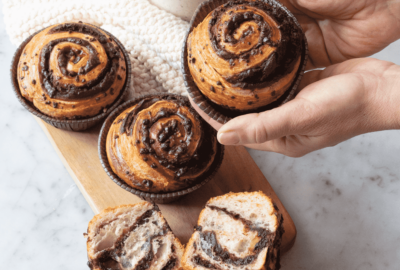There is no doubt that businesses across the hospitality sector are in a continuous cycle of learning, adapting and reviewing their operations and menus on an accelerated level as a result of the pandemic. Enforced lockdowns and social distancing measures have shaped change at pace – with early adopters clearly leading the race back to stabilising their operations.
Although pubs, bars, restaurants and cafes are now open, the usual flow of traffic has been altered. In commercial zones, fewer people are working in the office as 43% of consumers are looking to work from home more often. This potentially shifts the balance of breakfast, lunchtime and evening trade into more residential and out of town locations. With consumers conscious about reducing their contact with others, and care homes and schools needing to deliver meals at a distance, we are experiencing a rise in the food-to-go and handheld snack market.
A DIVIDED MARKET – Consumers have consistently proven that when it comes to food, we fall into two camps depending upon our emotional needs. The onset of COVID-19 and a growing awareness of the health benefits of eating well could have a strong influence on future buying behaviours.
DID YOU KNOW? ONLINE TAKEAWAY DELIVERY PLATFORM FOODHUB REVEALED DEMAND FOR THE NATION’S FAVOURITE FOOD HAS DOUBLED SINCE LOCKDOWN. SALES INCLUDE: QUARTER POUNDER BURGERS +158%, DONER KEBABS +156%, SAUSAGE & CHIPS +152%, CHICKEN BURGERS +147%, CHICKEN NUGGETS +146%
Research by consumer experts FMCG Gurus indicates that just over 70% of people surveyed said they planned to eat more healthily since the pandemic began. At first glance, this is great news for the health food sector, however good intentions do not always equate to actual change. A survey by Obesity Action Scotland conversely shows that 65% of young people were eating more confectionary and 60% of all respondents had made no changes to their fruit and veg intake since lockdown. In this current consumer market, it seems that there are moments when we crave something healthy and delicious and then there’s those moments when only comfort food will do.
MENU INSPIRATION – It appears this split between heath food and comfort food is here to stay, so how can a caterer accommodate these needs in a market that demands more takeaway and handheld food? To encourage healthy eating, items such as super seed porridge pots for breakfast, fruit bowls and protein pots are simple additions to the menu and work well as snacks and takeaway options.
Grains such as rye are also trending due to an increase in evidence of the associated health benefits such as assisting with weight management and type two diabetes. Swedish baker Polarbröd are currently offering a variety of 5 different rye flatbreads and thinbreads as sandwich and breakfast options across all sectors.
Serving the vegan market, jackfruit continues to be a strong, low cost option for sandwich fillings and street food items. Mark Wallace, Senior National Accounts Manager at Creative Foods Europe comments “BBQ Pulled Jackfruit is a great alternative to pulled pork and is an on-trend vegan and vegetarian filling. Its versatility enables caterers to serve the jackfruit filling in multiple ways, therefore requiring less ingredients in the kitchen.”
Similarly, halloumi has recently seen an uptick in demand due to its versatility and the growth in vegetarianism and is now one of the fastest growing varieties in the Continental cheese market, although not all recipes suit the needs of the health conscious consumer. “Halloumi is experiencing amazing demand partly due to the increased popularity we’ve seen of halloumi fries” says Craig Brayshaw, Commercial Director, Eurilait Ltd.
Outside of the vegan/vegetarian market, chicken continues to prove itself as the nation’s favourite. Not only is it a flexible flavour partner for dishes across the spectrum, it also travels well for delivery. “To increase sales, why not consider tempting customers with a tasty, US-style ‘chicken and waffles’ or ‘chicken and doughnuts’ breakfast?” suggests Gordon Lauder, MD of frozen food distributor Central Foods.
Global influences are prevalent in the takeaway and handheld food sector with street food appealing to many consumers for meals from breakfast to dinner; “Bao buns are one of the hottest current trends when it comes to handheld snacks and they lend themselves perfectly to a range of different serving situations, which is really convenient for foodservice operators who need to be flexible with their offering at this uncertain time,” continues Gordon Lauder.
The variety of flavours and options offered by street food will be key to developing enticing menus for the food-to-go market. Take a look at our Street Food Trend Report for an in-depth guide to this growing sector and learn how to translate a cross section of international dishes into your offering. https://stiritupmagazine.co.uk/pageturners/ stir-it-up/street-food-trend-report/
CARING FOR THE ELDERLY – In the care sector, operators have been navigating a new-found set of obstacles as they try to incorporate the social elements of mealtimes while respecting distancing rules. Matt Nicholas, Development Manager, Atalian Servest comments “We have termed it ‘personal distancing’ rather than social distancing to alleviate the isolation caused by losing the community dining element in our care homes.”
Residents have enjoyed a variety of handheld snacks, served as part of a theme to encourage engagement. Lunch has been presented in picnic boxes complete with picnic blankets and teams have decorated ice cream trollies, dressing up in old fashioned uniforms to bring back memories. Atalian Services have also provided care homes with bespoke newsletters, delivered to every resident advertising sweet treats and snacks available to order that day, ensuring no-one is left isolated and hungry.
TABLE SERVICE & TAKEAWAYS – In the education sector, schools have been re-working their meal plans to cater for a more simple lunch and breakfast menu, with meals that can be served to pupils at their table.
80% of TUCO members stated that they would be providing takeaway options to students over the coming months.
Drawing from experience in the OOH sector, caterers in the education sector can also adapt learnings from street food vendors to develop workable solutions that provide healthy meals in a “to-go” format. “It will be important for school caterers to recognise their canteens will not be used in the same way they were when schools reopen in September. Students will be more inclined to eat outdoors (weather permitting) therefore grab-and-go dishes should be high on the agenda.” Says Simon Solway, Country Manager OOH UK & Ireland, Santa Maria Foodservice, “Dishes like tacos, quesadillas, loaded fries and ready packaged salads all share the benefits of quick turnaround times and are primarily self-contained, perfect for students to takeaway and consume where they feel most comfortable.”
The hospitality industry, despite it’s woes this year does have our love of global flavours to celebrate. Consumers in the UK and Ireland have never been as brave or adventurous when eating out of home, providing a pool of inspiration as rich in menu options as it is in breadth of global influences, transforming the food-to-go and handheld snack market.
Adopting an Adapt and Survive Strategy
Businesses are working together and inspiring each other to adapt and survive the pandemic, with many taking bold decisions to completely transform their businesses. Here is a snap shot of some of the efforts that are taking place throughout the industry.
TRANSFORMING THE TEA SHOP – Rosie Lea is an established tea shop with two locations in Hampshire, one of which was too small to safely meet the eat-in trading requirements. The team developed compostable, branded cake boxes and changed their offering to a fully fledged ice cream parlour and bakery featuring homemade bakes in ice cream sundaes and decadent tiered cakes to take away.
RADICAL RENOVATIONS – Vegan restaurant DASH in Covent Garden were due to open just before the pandemic struck. Their premises featured newly installed floor to ceiling glass windows, but following lockdown, the team made the brave decision to rip out the windows and turn it into a counter space with a sliding glass frontage, enabling
customers to browse, order and pick up purchases from outside the shop contact-free. The team have also reduced their menu, focussing on best sellers to keep wastage at a minimum and aid the decision making process for customers.
DELIVERIES DRIVE DIVERSIFICATION – Chef turned restaurateur Andreas Antona, launched a takeaway and delivery service during lockdown to safeguard jobs for his staff at Simpsons and The Cross. The concept was well received and Andreas is launching his new brand “Andreas at Home”, with longer terms goals to provide the ultimate at home dining experience.
Speaking of the concept behind the diversification, Andreas says, “There was so much uncertainty surrounding what restaurants would look like postCOVID19 that I couldn’t just sit at home and wait. I had to go out, face the challenges and find new ways to reach customers. The nature of dining is changing and by offering delivery we have the opportunity to cook and sell delicious food to make our customers happy in a safe and sustainable way.”


